Financial Report: Accounting Standards, Budgeting, and Tax Obligations
VerifiedAdded on 2020/10/05
|11
|3141
|136
Report
AI Summary
This report provides a comprehensive overview of key financial concepts and practices. It begins with an examination of the relationship between Australian Accounting Standards and accounting principles, financial probity, and the limitations of balance sheets in portraying profitability. The report then delves into the value of break-even analysis, fringe benefit tax requirements, and cash flow analysis ratios. It explores organizational planning, financial cycles, and the use of business software. The report includes ratio calculations, tax obligations, and the relationship between zero-based budgeting and resource allocation. It also covers audit trails, variance analysis, accounts receivable aging, statutory requirements affecting financial reports, risk management tools, and internal controls. Furthermore, it provides insights into financial report requirements, issue identification techniques, and internal audit checklists.
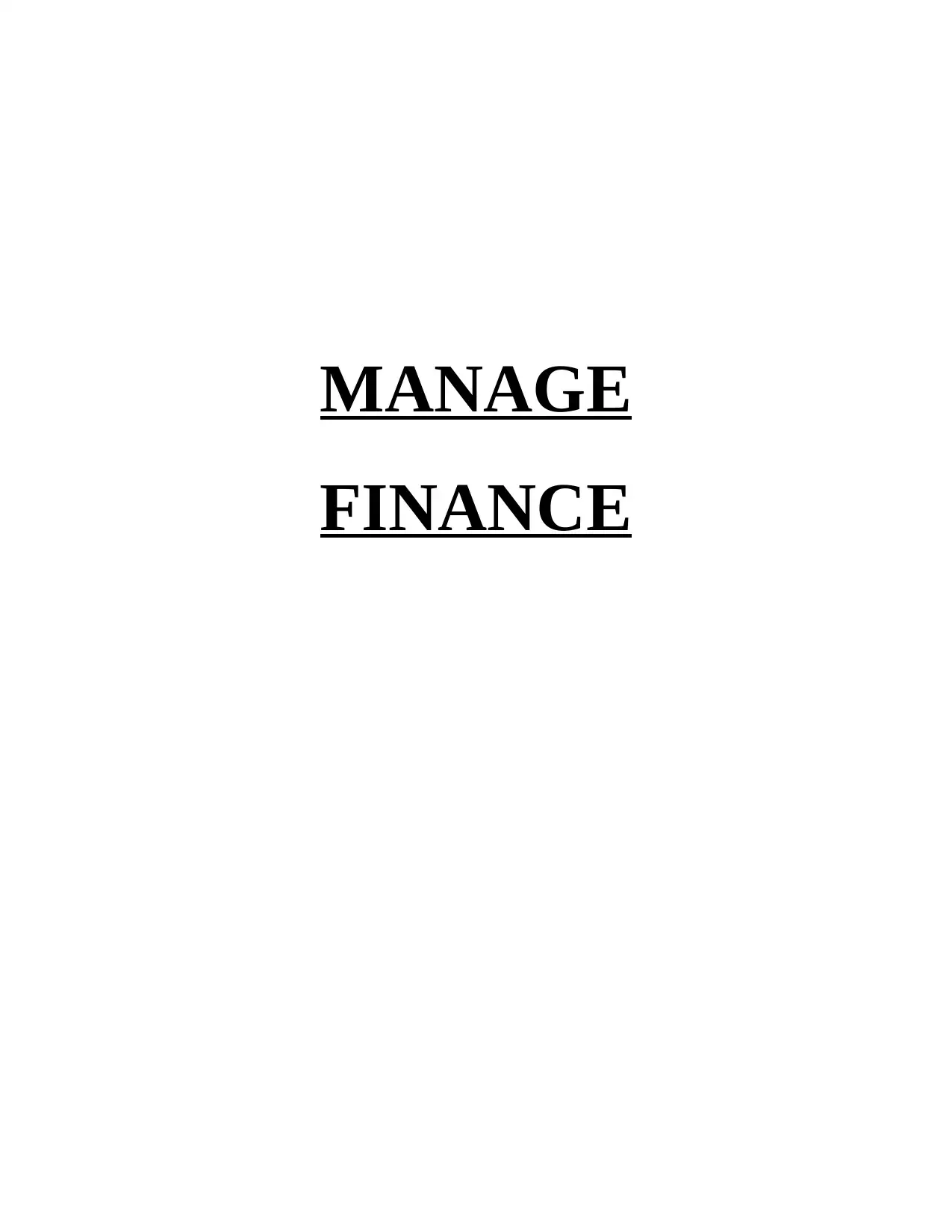
MANAGE
FINANCE
FINANCE
Paraphrase This Document
Need a fresh take? Get an instant paraphrase of this document with our AI Paraphraser
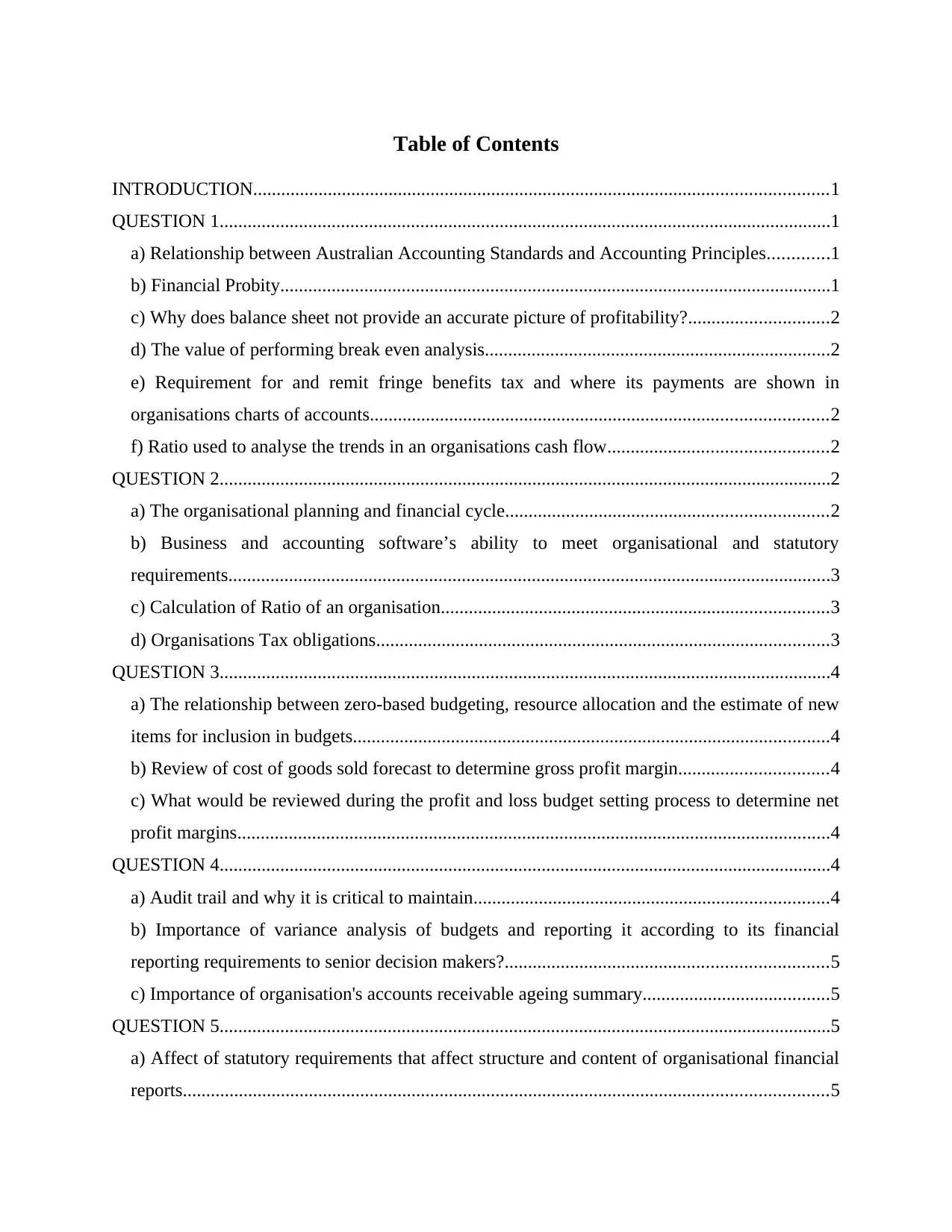
Table of Contents
INTRODUCTION...........................................................................................................................1
QUESTION 1...................................................................................................................................1
a) Relationship between Australian Accounting Standards and Accounting Principles.............1
b) Financial Probity......................................................................................................................1
c) Why does balance sheet not provide an accurate picture of profitability?..............................2
d) The value of performing break even analysis..........................................................................2
e) Requirement for and remit fringe benefits tax and where its payments are shown in
organisations charts of accounts..................................................................................................2
f) Ratio used to analyse the trends in an organisations cash flow...............................................2
QUESTION 2...................................................................................................................................2
a) The organisational planning and financial cycle.....................................................................2
b) Business and accounting software’s ability to meet organisational and statutory
requirements.................................................................................................................................3
c) Calculation of Ratio of an organisation...................................................................................3
d) Organisations Tax obligations.................................................................................................3
QUESTION 3...................................................................................................................................4
a) The relationship between zero-based budgeting, resource allocation and the estimate of new
items for inclusion in budgets......................................................................................................4
b) Review of cost of goods sold forecast to determine gross profit margin................................4
c) What would be reviewed during the profit and loss budget setting process to determine net
profit margins...............................................................................................................................4
QUESTION 4...................................................................................................................................4
a) Audit trail and why it is critical to maintain............................................................................4
b) Importance of variance analysis of budgets and reporting it according to its financial
reporting requirements to senior decision makers?.....................................................................5
c) Importance of organisation's accounts receivable ageing summary........................................5
QUESTION 5...................................................................................................................................5
a) Affect of statutory requirements that affect structure and content of organisational financial
reports..........................................................................................................................................5
INTRODUCTION...........................................................................................................................1
QUESTION 1...................................................................................................................................1
a) Relationship between Australian Accounting Standards and Accounting Principles.............1
b) Financial Probity......................................................................................................................1
c) Why does balance sheet not provide an accurate picture of profitability?..............................2
d) The value of performing break even analysis..........................................................................2
e) Requirement for and remit fringe benefits tax and where its payments are shown in
organisations charts of accounts..................................................................................................2
f) Ratio used to analyse the trends in an organisations cash flow...............................................2
QUESTION 2...................................................................................................................................2
a) The organisational planning and financial cycle.....................................................................2
b) Business and accounting software’s ability to meet organisational and statutory
requirements.................................................................................................................................3
c) Calculation of Ratio of an organisation...................................................................................3
d) Organisations Tax obligations.................................................................................................3
QUESTION 3...................................................................................................................................4
a) The relationship between zero-based budgeting, resource allocation and the estimate of new
items for inclusion in budgets......................................................................................................4
b) Review of cost of goods sold forecast to determine gross profit margin................................4
c) What would be reviewed during the profit and loss budget setting process to determine net
profit margins...............................................................................................................................4
QUESTION 4...................................................................................................................................4
a) Audit trail and why it is critical to maintain............................................................................4
b) Importance of variance analysis of budgets and reporting it according to its financial
reporting requirements to senior decision makers?.....................................................................5
c) Importance of organisation's accounts receivable ageing summary........................................5
QUESTION 5...................................................................................................................................5
a) Affect of statutory requirements that affect structure and content of organisational financial
reports..........................................................................................................................................5
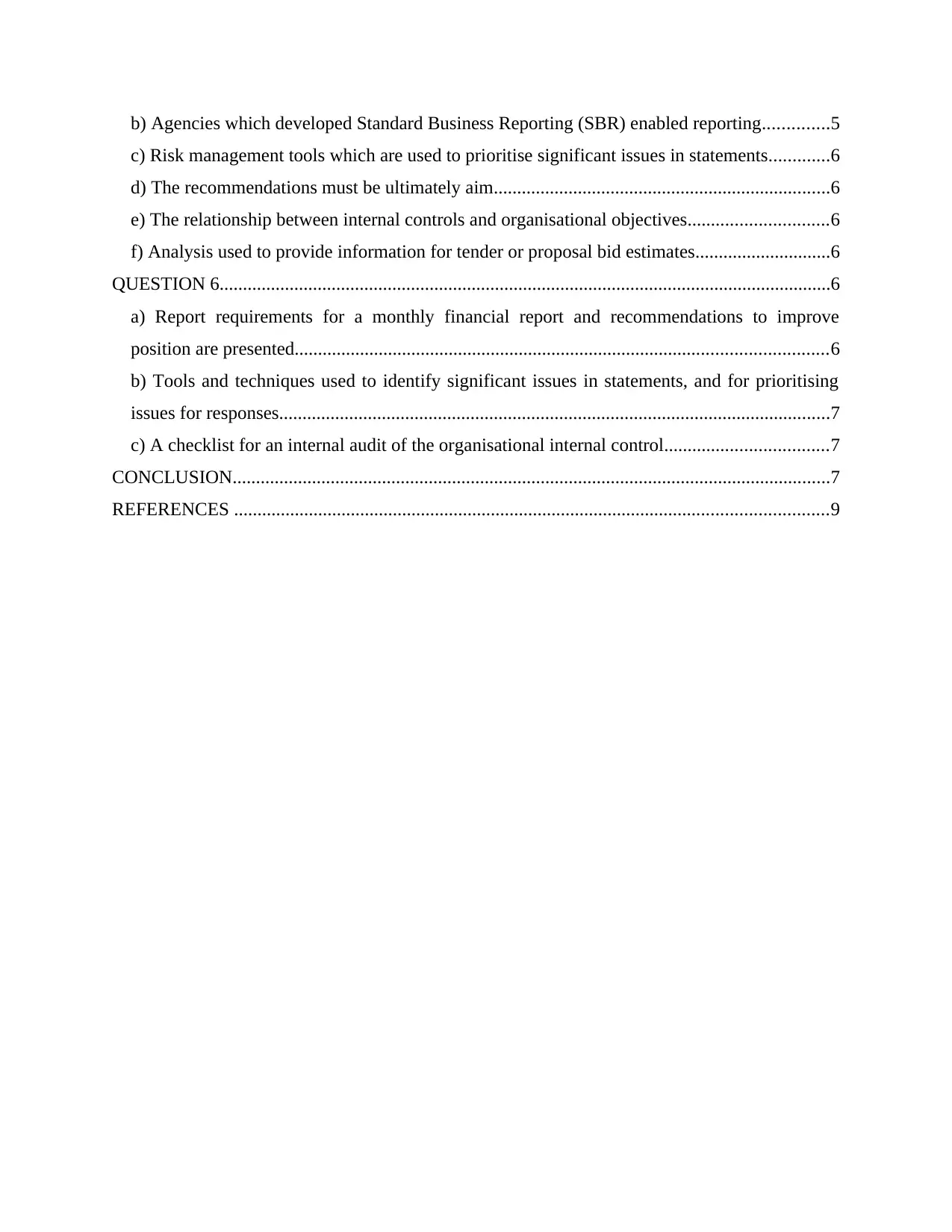
b) Agencies which developed Standard Business Reporting (SBR) enabled reporting..............5
c) Risk management tools which are used to prioritise significant issues in statements.............6
d) The recommendations must be ultimately aim........................................................................6
e) The relationship between internal controls and organisational objectives..............................6
f) Analysis used to provide information for tender or proposal bid estimates.............................6
QUESTION 6...................................................................................................................................6
a) Report requirements for a monthly financial report and recommendations to improve
position are presented..................................................................................................................6
b) Tools and techniques used to identify significant issues in statements, and for prioritising
issues for responses......................................................................................................................7
c) A checklist for an internal audit of the organisational internal control...................................7
CONCLUSION................................................................................................................................7
REFERENCES ...............................................................................................................................9
c) Risk management tools which are used to prioritise significant issues in statements.............6
d) The recommendations must be ultimately aim........................................................................6
e) The relationship between internal controls and organisational objectives..............................6
f) Analysis used to provide information for tender or proposal bid estimates.............................6
QUESTION 6...................................................................................................................................6
a) Report requirements for a monthly financial report and recommendations to improve
position are presented..................................................................................................................6
b) Tools and techniques used to identify significant issues in statements, and for prioritising
issues for responses......................................................................................................................7
c) A checklist for an internal audit of the organisational internal control...................................7
CONCLUSION................................................................................................................................7
REFERENCES ...............................................................................................................................9
⊘ This is a preview!⊘
Do you want full access?
Subscribe today to unlock all pages.

Trusted by 1+ million students worldwide
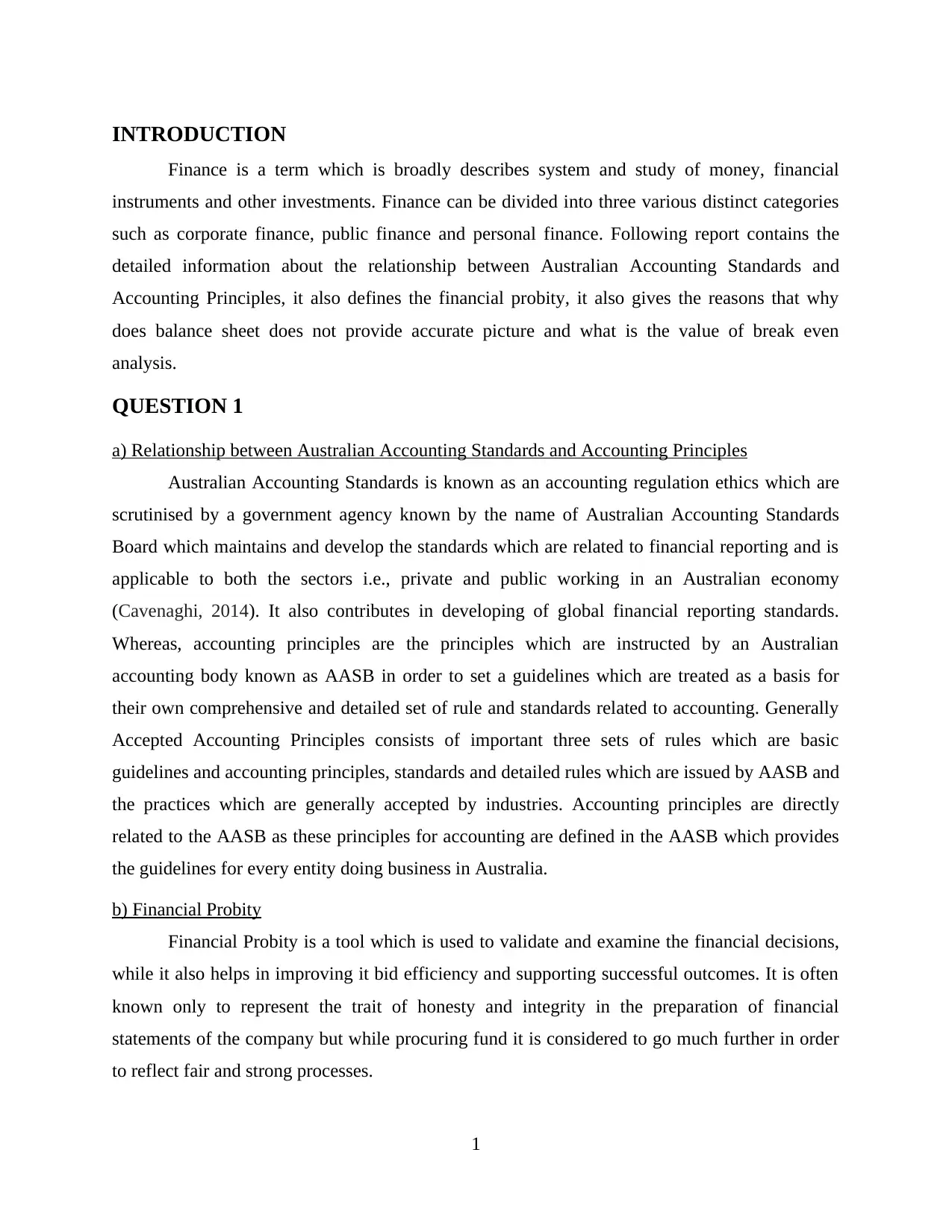
INTRODUCTION
Finance is a term which is broadly describes system and study of money, financial
instruments and other investments. Finance can be divided into three various distinct categories
such as corporate finance, public finance and personal finance. Following report contains the
detailed information about the relationship between Australian Accounting Standards and
Accounting Principles, it also defines the financial probity, it also gives the reasons that why
does balance sheet does not provide accurate picture and what is the value of break even
analysis.
QUESTION 1
a) Relationship between Australian Accounting Standards and Accounting Principles
Australian Accounting Standards is known as an accounting regulation ethics which are
scrutinised by a government agency known by the name of Australian Accounting Standards
Board which maintains and develop the standards which are related to financial reporting and is
applicable to both the sectors i.e., private and public working in an Australian economy
(Cavenaghi, 2014). It also contributes in developing of global financial reporting standards.
Whereas, accounting principles are the principles which are instructed by an Australian
accounting body known as AASB in order to set a guidelines which are treated as a basis for
their own comprehensive and detailed set of rule and standards related to accounting. Generally
Accepted Accounting Principles consists of important three sets of rules which are basic
guidelines and accounting principles, standards and detailed rules which are issued by AASB and
the practices which are generally accepted by industries. Accounting principles are directly
related to the AASB as these principles for accounting are defined in the AASB which provides
the guidelines for every entity doing business in Australia.
b) Financial Probity
Financial Probity is a tool which is used to validate and examine the financial decisions,
while it also helps in improving it bid efficiency and supporting successful outcomes. It is often
known only to represent the trait of honesty and integrity in the preparation of financial
statements of the company but while procuring fund it is considered to go much further in order
to reflect fair and strong processes.
1
Finance is a term which is broadly describes system and study of money, financial
instruments and other investments. Finance can be divided into three various distinct categories
such as corporate finance, public finance and personal finance. Following report contains the
detailed information about the relationship between Australian Accounting Standards and
Accounting Principles, it also defines the financial probity, it also gives the reasons that why
does balance sheet does not provide accurate picture and what is the value of break even
analysis.
QUESTION 1
a) Relationship between Australian Accounting Standards and Accounting Principles
Australian Accounting Standards is known as an accounting regulation ethics which are
scrutinised by a government agency known by the name of Australian Accounting Standards
Board which maintains and develop the standards which are related to financial reporting and is
applicable to both the sectors i.e., private and public working in an Australian economy
(Cavenaghi, 2014). It also contributes in developing of global financial reporting standards.
Whereas, accounting principles are the principles which are instructed by an Australian
accounting body known as AASB in order to set a guidelines which are treated as a basis for
their own comprehensive and detailed set of rule and standards related to accounting. Generally
Accepted Accounting Principles consists of important three sets of rules which are basic
guidelines and accounting principles, standards and detailed rules which are issued by AASB and
the practices which are generally accepted by industries. Accounting principles are directly
related to the AASB as these principles for accounting are defined in the AASB which provides
the guidelines for every entity doing business in Australia.
b) Financial Probity
Financial Probity is a tool which is used to validate and examine the financial decisions,
while it also helps in improving it bid efficiency and supporting successful outcomes. It is often
known only to represent the trait of honesty and integrity in the preparation of financial
statements of the company but while procuring fund it is considered to go much further in order
to reflect fair and strong processes.
1
Paraphrase This Document
Need a fresh take? Get an instant paraphrase of this document with our AI Paraphraser
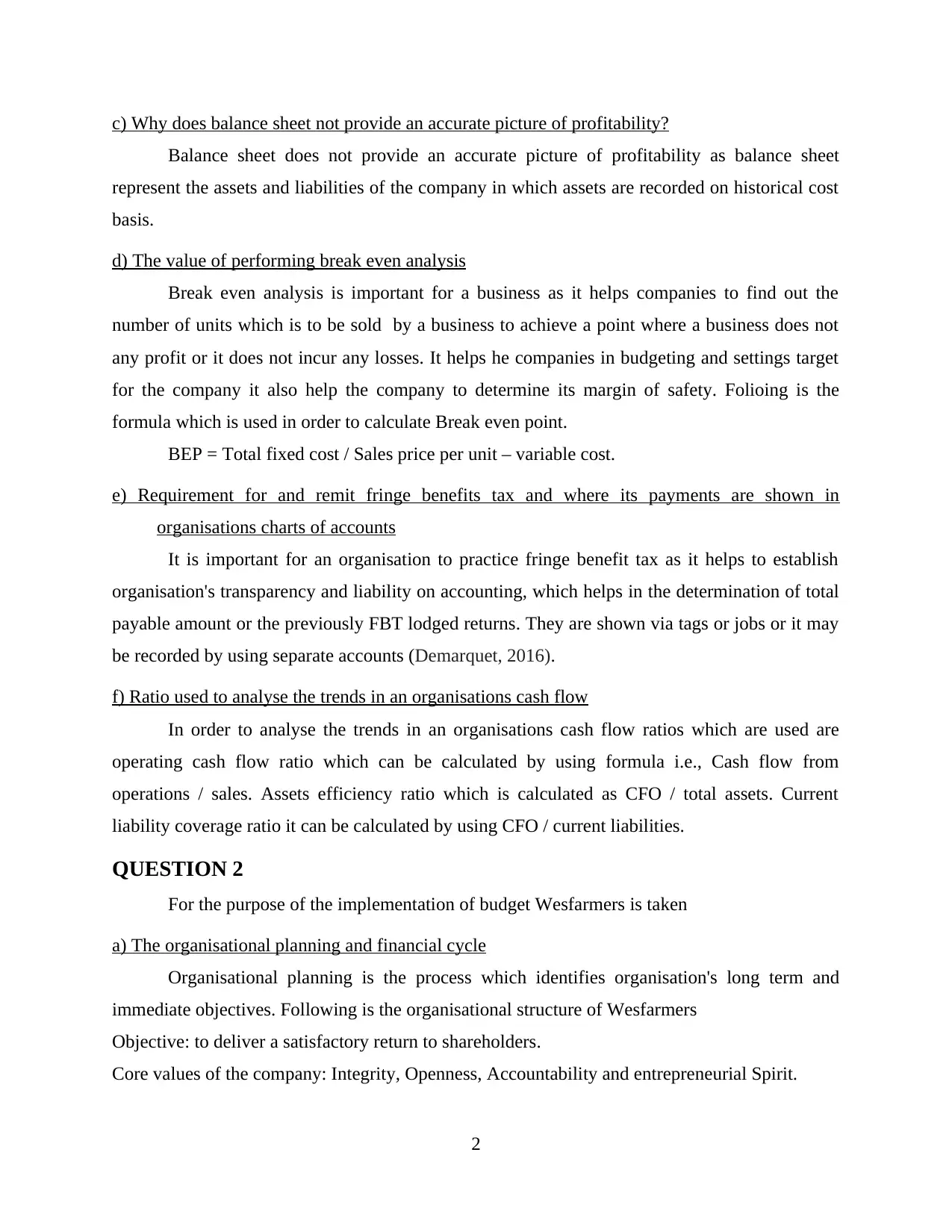
c) Why does balance sheet not provide an accurate picture of profitability?
Balance sheet does not provide an accurate picture of profitability as balance sheet
represent the assets and liabilities of the company in which assets are recorded on historical cost
basis.
d) The value of performing break even analysis
Break even analysis is important for a business as it helps companies to find out the
number of units which is to be sold by a business to achieve a point where a business does not
any profit or it does not incur any losses. It helps he companies in budgeting and settings target
for the company it also help the company to determine its margin of safety. Folioing is the
formula which is used in order to calculate Break even point.
BEP = Total fixed cost / Sales price per unit – variable cost.
e) Requirement for and remit fringe benefits tax and where its payments are shown in
organisations charts of accounts
It is important for an organisation to practice fringe benefit tax as it helps to establish
organisation's transparency and liability on accounting, which helps in the determination of total
payable amount or the previously FBT lodged returns. They are shown via tags or jobs or it may
be recorded by using separate accounts (Demarquet, 2016).
f) Ratio used to analyse the trends in an organisations cash flow
In order to analyse the trends in an organisations cash flow ratios which are used are
operating cash flow ratio which can be calculated by using formula i.e., Cash flow from
operations / sales. Assets efficiency ratio which is calculated as CFO / total assets. Current
liability coverage ratio it can be calculated by using CFO / current liabilities.
QUESTION 2
For the purpose of the implementation of budget Wesfarmers is taken
a) The organisational planning and financial cycle
Organisational planning is the process which identifies organisation's long term and
immediate objectives. Following is the organisational structure of Wesfarmers
Objective: to deliver a satisfactory return to shareholders.
Core values of the company: Integrity, Openness, Accountability and entrepreneurial Spirit.
2
Balance sheet does not provide an accurate picture of profitability as balance sheet
represent the assets and liabilities of the company in which assets are recorded on historical cost
basis.
d) The value of performing break even analysis
Break even analysis is important for a business as it helps companies to find out the
number of units which is to be sold by a business to achieve a point where a business does not
any profit or it does not incur any losses. It helps he companies in budgeting and settings target
for the company it also help the company to determine its margin of safety. Folioing is the
formula which is used in order to calculate Break even point.
BEP = Total fixed cost / Sales price per unit – variable cost.
e) Requirement for and remit fringe benefits tax and where its payments are shown in
organisations charts of accounts
It is important for an organisation to practice fringe benefit tax as it helps to establish
organisation's transparency and liability on accounting, which helps in the determination of total
payable amount or the previously FBT lodged returns. They are shown via tags or jobs or it may
be recorded by using separate accounts (Demarquet, 2016).
f) Ratio used to analyse the trends in an organisations cash flow
In order to analyse the trends in an organisations cash flow ratios which are used are
operating cash flow ratio which can be calculated by using formula i.e., Cash flow from
operations / sales. Assets efficiency ratio which is calculated as CFO / total assets. Current
liability coverage ratio it can be calculated by using CFO / current liabilities.
QUESTION 2
For the purpose of the implementation of budget Wesfarmers is taken
a) The organisational planning and financial cycle
Organisational planning is the process which identifies organisation's long term and
immediate objectives. Following is the organisational structure of Wesfarmers
Objective: to deliver a satisfactory return to shareholders.
Core values of the company: Integrity, Openness, Accountability and entrepreneurial Spirit.
2
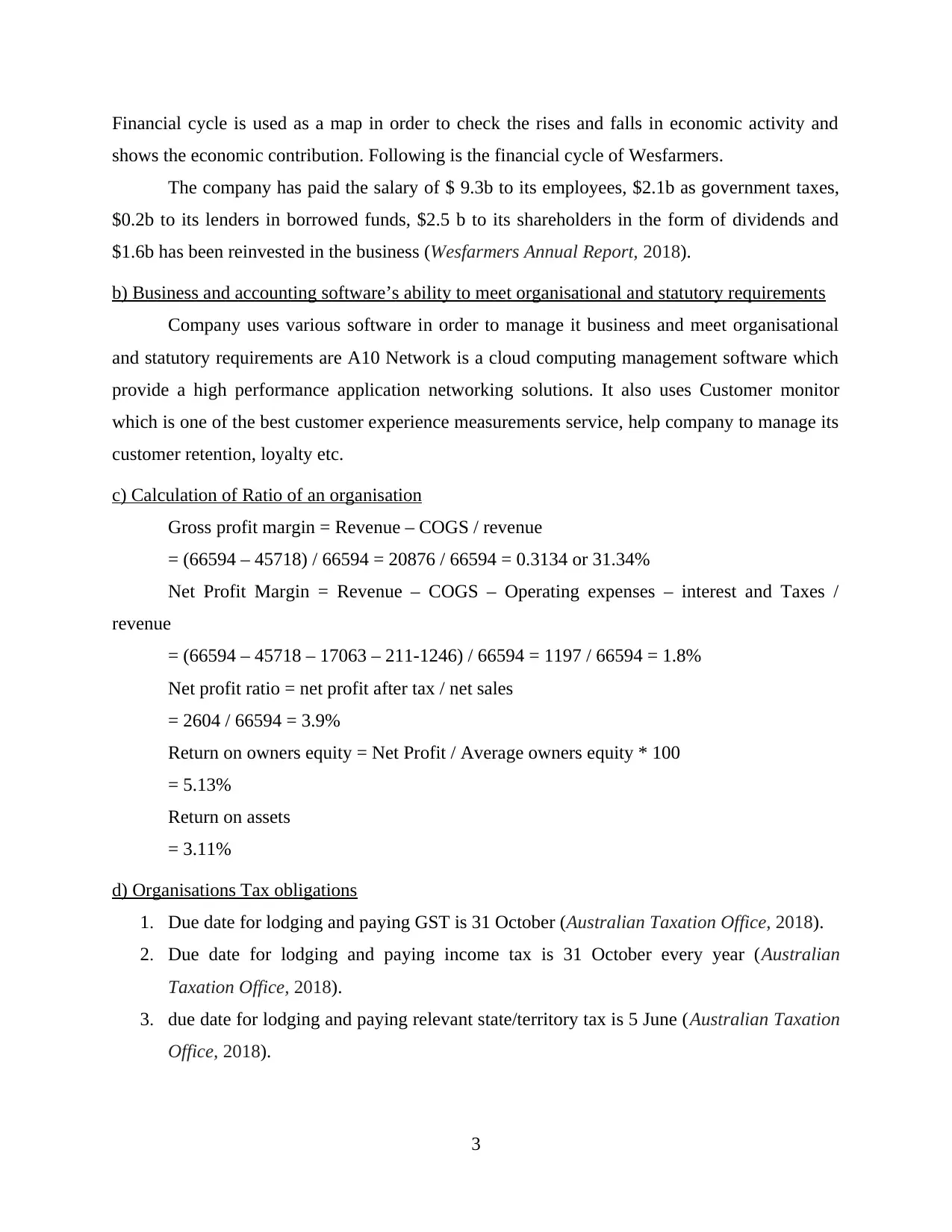
Financial cycle is used as a map in order to check the rises and falls in economic activity and
shows the economic contribution. Following is the financial cycle of Wesfarmers.
The company has paid the salary of $ 9.3b to its employees, $2.1b as government taxes,
$0.2b to its lenders in borrowed funds, $2.5 b to its shareholders in the form of dividends and
$1.6b has been reinvested in the business (Wesfarmers Annual Report, 2018).
b) Business and accounting software’s ability to meet organisational and statutory requirements
Company uses various software in order to manage it business and meet organisational
and statutory requirements are A10 Network is a cloud computing management software which
provide a high performance application networking solutions. It also uses Customer monitor
which is one of the best customer experience measurements service, help company to manage its
customer retention, loyalty etc.
c) Calculation of Ratio of an organisation
Gross profit margin = Revenue – COGS / revenue
= (66594 – 45718) / 66594 = 20876 / 66594 = 0.3134 or 31.34%
Net Profit Margin = Revenue – COGS – Operating expenses – interest and Taxes /
revenue
= (66594 – 45718 – 17063 – 211-1246) / 66594 = 1197 / 66594 = 1.8%
Net profit ratio = net profit after tax / net sales
= 2604 / 66594 = 3.9%
Return on owners equity = Net Profit / Average owners equity * 100
= 5.13%
Return on assets
= 3.11%
d) Organisations Tax obligations
1. Due date for lodging and paying GST is 31 October (Australian Taxation Office, 2018).
2. Due date for lodging and paying income tax is 31 October every year (Australian
Taxation Office, 2018).
3. due date for lodging and paying relevant state/territory tax is 5 June (Australian Taxation
Office, 2018).
3
shows the economic contribution. Following is the financial cycle of Wesfarmers.
The company has paid the salary of $ 9.3b to its employees, $2.1b as government taxes,
$0.2b to its lenders in borrowed funds, $2.5 b to its shareholders in the form of dividends and
$1.6b has been reinvested in the business (Wesfarmers Annual Report, 2018).
b) Business and accounting software’s ability to meet organisational and statutory requirements
Company uses various software in order to manage it business and meet organisational
and statutory requirements are A10 Network is a cloud computing management software which
provide a high performance application networking solutions. It also uses Customer monitor
which is one of the best customer experience measurements service, help company to manage its
customer retention, loyalty etc.
c) Calculation of Ratio of an organisation
Gross profit margin = Revenue – COGS / revenue
= (66594 – 45718) / 66594 = 20876 / 66594 = 0.3134 or 31.34%
Net Profit Margin = Revenue – COGS – Operating expenses – interest and Taxes /
revenue
= (66594 – 45718 – 17063 – 211-1246) / 66594 = 1197 / 66594 = 1.8%
Net profit ratio = net profit after tax / net sales
= 2604 / 66594 = 3.9%
Return on owners equity = Net Profit / Average owners equity * 100
= 5.13%
Return on assets
= 3.11%
d) Organisations Tax obligations
1. Due date for lodging and paying GST is 31 October (Australian Taxation Office, 2018).
2. Due date for lodging and paying income tax is 31 October every year (Australian
Taxation Office, 2018).
3. due date for lodging and paying relevant state/territory tax is 5 June (Australian Taxation
Office, 2018).
3
⊘ This is a preview!⊘
Do you want full access?
Subscribe today to unlock all pages.

Trusted by 1+ million students worldwide
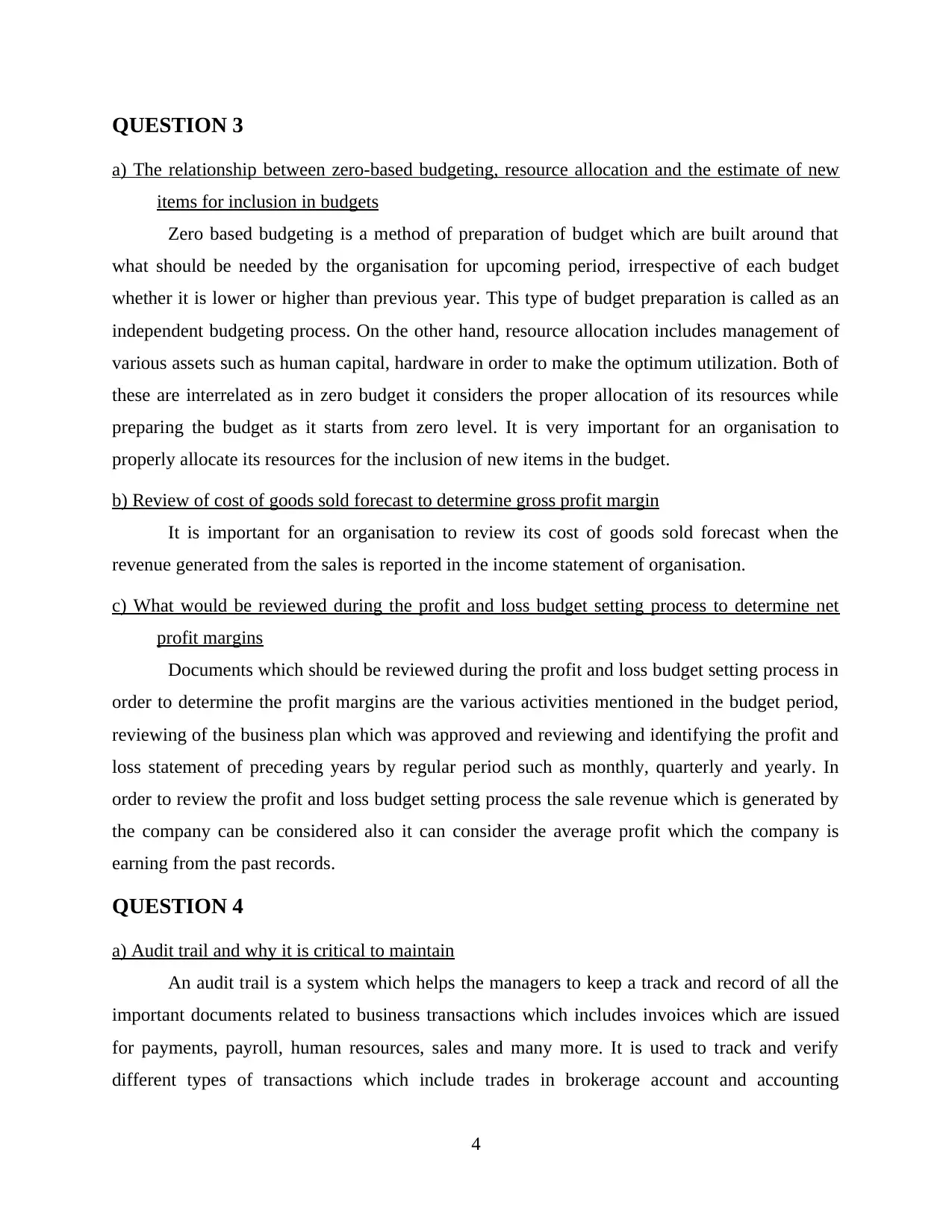
QUESTION 3
a) The relationship between zero-based budgeting, resource allocation and the estimate of new
items for inclusion in budgets
Zero based budgeting is a method of preparation of budget which are built around that
what should be needed by the organisation for upcoming period, irrespective of each budget
whether it is lower or higher than previous year. This type of budget preparation is called as an
independent budgeting process. On the other hand, resource allocation includes management of
various assets such as human capital, hardware in order to make the optimum utilization. Both of
these are interrelated as in zero budget it considers the proper allocation of its resources while
preparing the budget as it starts from zero level. It is very important for an organisation to
properly allocate its resources for the inclusion of new items in the budget.
b) Review of cost of goods sold forecast to determine gross profit margin
It is important for an organisation to review its cost of goods sold forecast when the
revenue generated from the sales is reported in the income statement of organisation.
c) What would be reviewed during the profit and loss budget setting process to determine net
profit margins
Documents which should be reviewed during the profit and loss budget setting process in
order to determine the profit margins are the various activities mentioned in the budget period,
reviewing of the business plan which was approved and reviewing and identifying the profit and
loss statement of preceding years by regular period such as monthly, quarterly and yearly. In
order to review the profit and loss budget setting process the sale revenue which is generated by
the company can be considered also it can consider the average profit which the company is
earning from the past records.
QUESTION 4
a) Audit trail and why it is critical to maintain
An audit trail is a system which helps the managers to keep a track and record of all the
important documents related to business transactions which includes invoices which are issued
for payments, payroll, human resources, sales and many more. It is used to track and verify
different types of transactions which include trades in brokerage account and accounting
4
a) The relationship between zero-based budgeting, resource allocation and the estimate of new
items for inclusion in budgets
Zero based budgeting is a method of preparation of budget which are built around that
what should be needed by the organisation for upcoming period, irrespective of each budget
whether it is lower or higher than previous year. This type of budget preparation is called as an
independent budgeting process. On the other hand, resource allocation includes management of
various assets such as human capital, hardware in order to make the optimum utilization. Both of
these are interrelated as in zero budget it considers the proper allocation of its resources while
preparing the budget as it starts from zero level. It is very important for an organisation to
properly allocate its resources for the inclusion of new items in the budget.
b) Review of cost of goods sold forecast to determine gross profit margin
It is important for an organisation to review its cost of goods sold forecast when the
revenue generated from the sales is reported in the income statement of organisation.
c) What would be reviewed during the profit and loss budget setting process to determine net
profit margins
Documents which should be reviewed during the profit and loss budget setting process in
order to determine the profit margins are the various activities mentioned in the budget period,
reviewing of the business plan which was approved and reviewing and identifying the profit and
loss statement of preceding years by regular period such as monthly, quarterly and yearly. In
order to review the profit and loss budget setting process the sale revenue which is generated by
the company can be considered also it can consider the average profit which the company is
earning from the past records.
QUESTION 4
a) Audit trail and why it is critical to maintain
An audit trail is a system which helps the managers to keep a track and record of all the
important documents related to business transactions which includes invoices which are issued
for payments, payroll, human resources, sales and many more. It is used to track and verify
different types of transactions which include trades in brokerage account and accounting
4
Paraphrase This Document
Need a fresh take? Get an instant paraphrase of this document with our AI Paraphraser
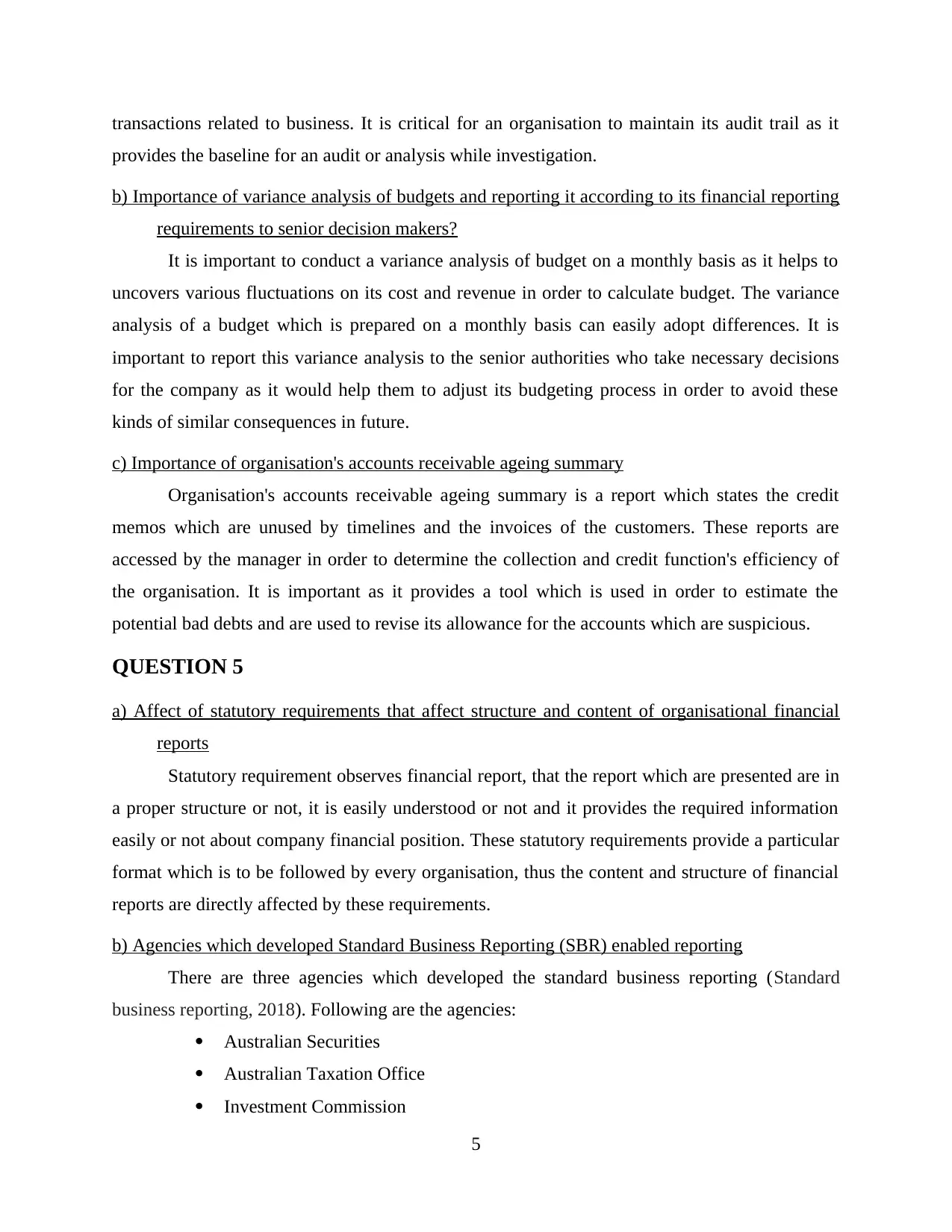
transactions related to business. It is critical for an organisation to maintain its audit trail as it
provides the baseline for an audit or analysis while investigation.
b) Importance of variance analysis of budgets and reporting it according to its financial reporting
requirements to senior decision makers?
It is important to conduct a variance analysis of budget on a monthly basis as it helps to
uncovers various fluctuations on its cost and revenue in order to calculate budget. The variance
analysis of a budget which is prepared on a monthly basis can easily adopt differences. It is
important to report this variance analysis to the senior authorities who take necessary decisions
for the company as it would help them to adjust its budgeting process in order to avoid these
kinds of similar consequences in future.
c) Importance of organisation's accounts receivable ageing summary
Organisation's accounts receivable ageing summary is a report which states the credit
memos which are unused by timelines and the invoices of the customers. These reports are
accessed by the manager in order to determine the collection and credit function's efficiency of
the organisation. It is important as it provides a tool which is used in order to estimate the
potential bad debts and are used to revise its allowance for the accounts which are suspicious.
QUESTION 5
a) Affect of statutory requirements that affect structure and content of organisational financial
reports
Statutory requirement observes financial report, that the report which are presented are in
a proper structure or not, it is easily understood or not and it provides the required information
easily or not about company financial position. These statutory requirements provide a particular
format which is to be followed by every organisation, thus the content and structure of financial
reports are directly affected by these requirements.
b) Agencies which developed Standard Business Reporting (SBR) enabled reporting
There are three agencies which developed the standard business reporting (Standard
business reporting, 2018). Following are the agencies:
Australian Securities
Australian Taxation Office
Investment Commission
5
provides the baseline for an audit or analysis while investigation.
b) Importance of variance analysis of budgets and reporting it according to its financial reporting
requirements to senior decision makers?
It is important to conduct a variance analysis of budget on a monthly basis as it helps to
uncovers various fluctuations on its cost and revenue in order to calculate budget. The variance
analysis of a budget which is prepared on a monthly basis can easily adopt differences. It is
important to report this variance analysis to the senior authorities who take necessary decisions
for the company as it would help them to adjust its budgeting process in order to avoid these
kinds of similar consequences in future.
c) Importance of organisation's accounts receivable ageing summary
Organisation's accounts receivable ageing summary is a report which states the credit
memos which are unused by timelines and the invoices of the customers. These reports are
accessed by the manager in order to determine the collection and credit function's efficiency of
the organisation. It is important as it provides a tool which is used in order to estimate the
potential bad debts and are used to revise its allowance for the accounts which are suspicious.
QUESTION 5
a) Affect of statutory requirements that affect structure and content of organisational financial
reports
Statutory requirement observes financial report, that the report which are presented are in
a proper structure or not, it is easily understood or not and it provides the required information
easily or not about company financial position. These statutory requirements provide a particular
format which is to be followed by every organisation, thus the content and structure of financial
reports are directly affected by these requirements.
b) Agencies which developed Standard Business Reporting (SBR) enabled reporting
There are three agencies which developed the standard business reporting (Standard
business reporting, 2018). Following are the agencies:
Australian Securities
Australian Taxation Office
Investment Commission
5
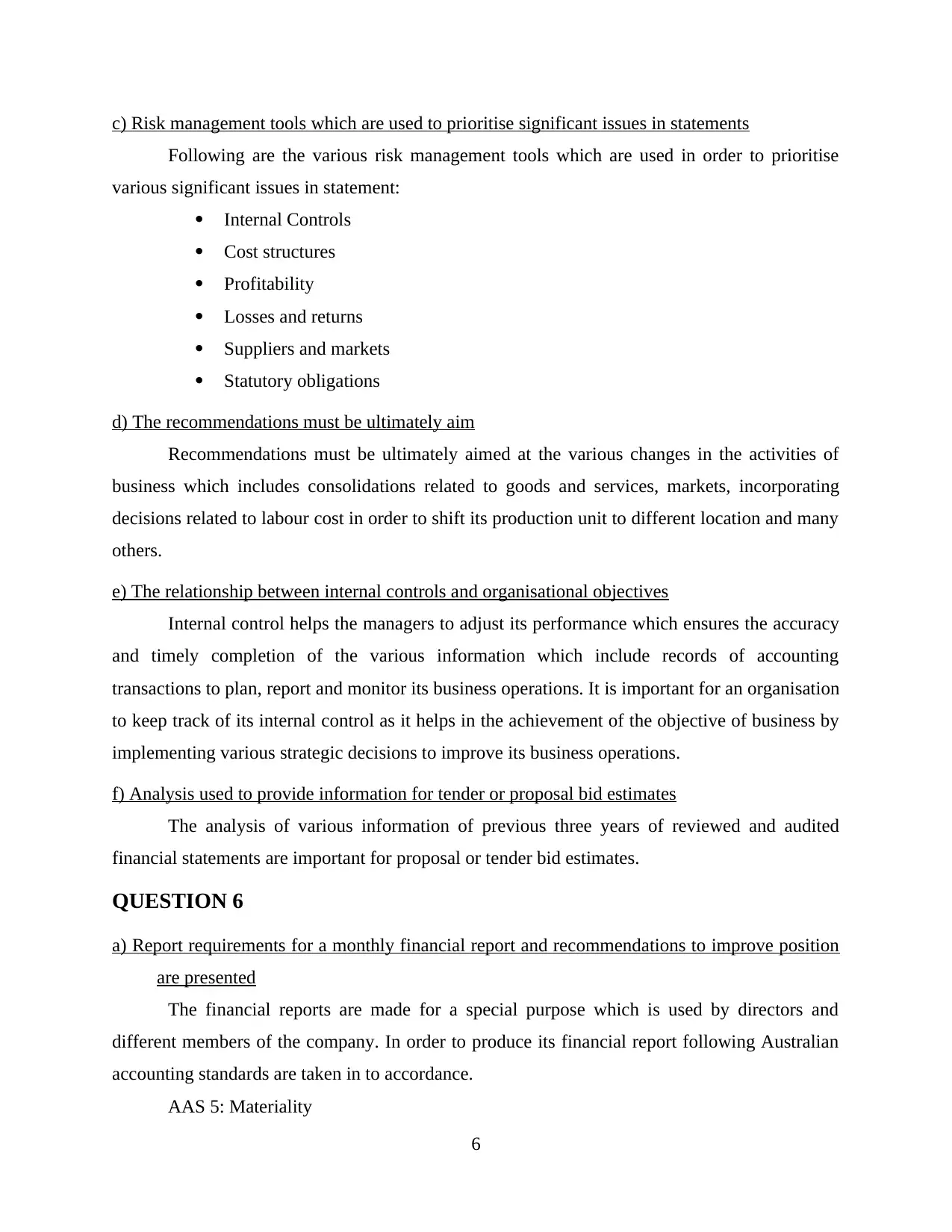
c) Risk management tools which are used to prioritise significant issues in statements
Following are the various risk management tools which are used in order to prioritise
various significant issues in statement:
Internal Controls
Cost structures
Profitability
Losses and returns
Suppliers and markets
Statutory obligations
d) The recommendations must be ultimately aim
Recommendations must be ultimately aimed at the various changes in the activities of
business which includes consolidations related to goods and services, markets, incorporating
decisions related to labour cost in order to shift its production unit to different location and many
others.
e) The relationship between internal controls and organisational objectives
Internal control helps the managers to adjust its performance which ensures the accuracy
and timely completion of the various information which include records of accounting
transactions to plan, report and monitor its business operations. It is important for an organisation
to keep track of its internal control as it helps in the achievement of the objective of business by
implementing various strategic decisions to improve its business operations.
f) Analysis used to provide information for tender or proposal bid estimates
The analysis of various information of previous three years of reviewed and audited
financial statements are important for proposal or tender bid estimates.
QUESTION 6
a) Report requirements for a monthly financial report and recommendations to improve position
are presented
The financial reports are made for a special purpose which is used by directors and
different members of the company. In order to produce its financial report following Australian
accounting standards are taken in to accordance.
AAS 5: Materiality
6
Following are the various risk management tools which are used in order to prioritise
various significant issues in statement:
Internal Controls
Cost structures
Profitability
Losses and returns
Suppliers and markets
Statutory obligations
d) The recommendations must be ultimately aim
Recommendations must be ultimately aimed at the various changes in the activities of
business which includes consolidations related to goods and services, markets, incorporating
decisions related to labour cost in order to shift its production unit to different location and many
others.
e) The relationship between internal controls and organisational objectives
Internal control helps the managers to adjust its performance which ensures the accuracy
and timely completion of the various information which include records of accounting
transactions to plan, report and monitor its business operations. It is important for an organisation
to keep track of its internal control as it helps in the achievement of the objective of business by
implementing various strategic decisions to improve its business operations.
f) Analysis used to provide information for tender or proposal bid estimates
The analysis of various information of previous three years of reviewed and audited
financial statements are important for proposal or tender bid estimates.
QUESTION 6
a) Report requirements for a monthly financial report and recommendations to improve position
are presented
The financial reports are made for a special purpose which is used by directors and
different members of the company. In order to produce its financial report following Australian
accounting standards are taken in to accordance.
AAS 5: Materiality
6
⊘ This is a preview!⊘
Do you want full access?
Subscribe today to unlock all pages.

Trusted by 1+ million students worldwide
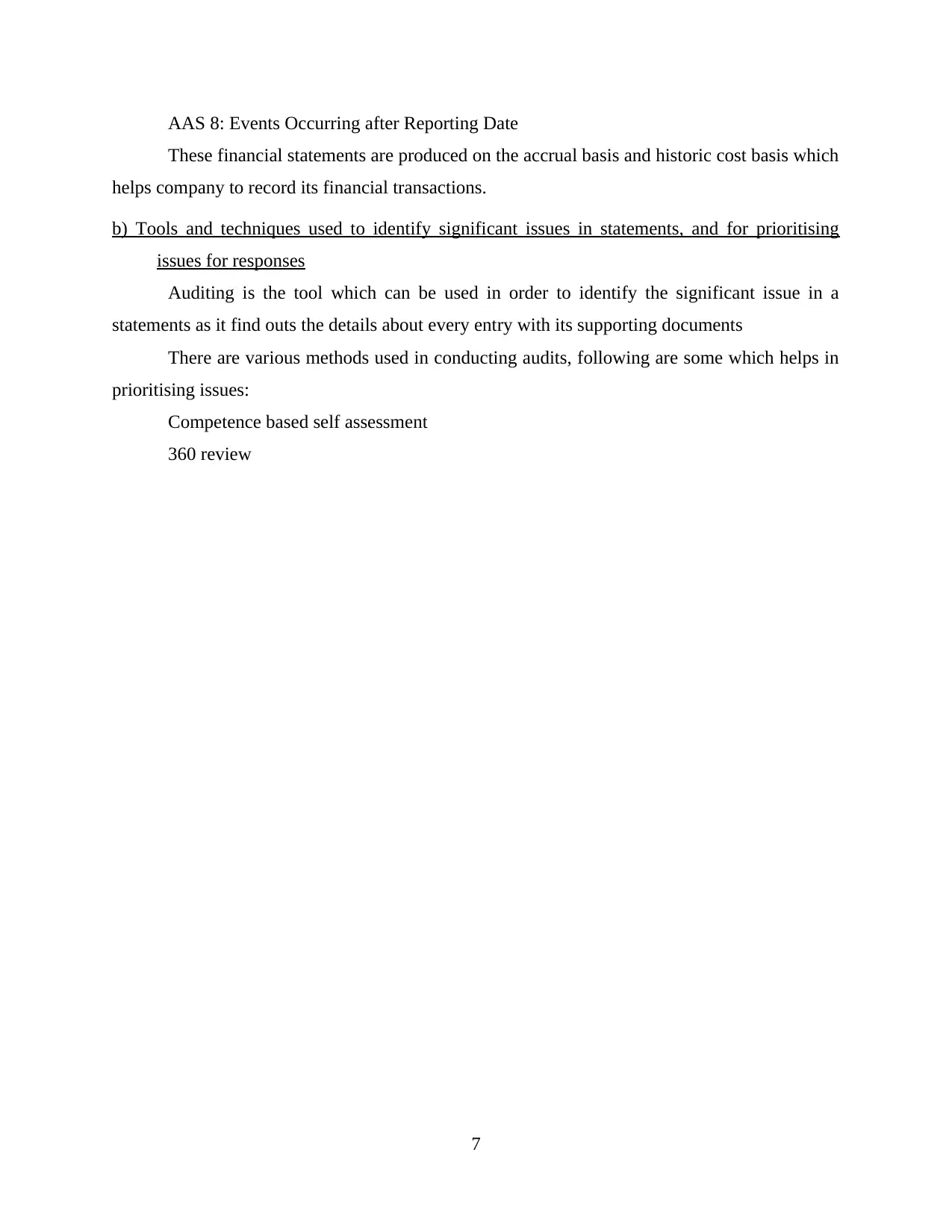
AAS 8: Events Occurring after Reporting Date
These financial statements are produced on the accrual basis and historic cost basis which
helps company to record its financial transactions.
b) Tools and techniques used to identify significant issues in statements, and for prioritising
issues for responses
Auditing is the tool which can be used in order to identify the significant issue in a
statements as it find outs the details about every entry with its supporting documents
There are various methods used in conducting audits, following are some which helps in
prioritising issues:
Competence based self assessment
360 review
7
These financial statements are produced on the accrual basis and historic cost basis which
helps company to record its financial transactions.
b) Tools and techniques used to identify significant issues in statements, and for prioritising
issues for responses
Auditing is the tool which can be used in order to identify the significant issue in a
statements as it find outs the details about every entry with its supporting documents
There are various methods used in conducting audits, following are some which helps in
prioritising issues:
Competence based self assessment
360 review
7
Paraphrase This Document
Need a fresh take? Get an instant paraphrase of this document with our AI Paraphraser

c) A checklist for an internal audit of the organisational internal control
8
8
1 out of 11
Related Documents
Your All-in-One AI-Powered Toolkit for Academic Success.
+13062052269
info@desklib.com
Available 24*7 on WhatsApp / Email
![[object Object]](/_next/static/media/star-bottom.7253800d.svg)
Unlock your academic potential
Copyright © 2020–2025 A2Z Services. All Rights Reserved. Developed and managed by ZUCOL.




![BSBFIM601 Manage Finances: Assessment Report, [Semester], [College]](/_next/image/?url=https%3A%2F%2Fdesklib.com%2Fmedia%2Fimages%2Fxm%2F162b9d69229e4e1db10d1eff3736f19c.jpg&w=256&q=75)